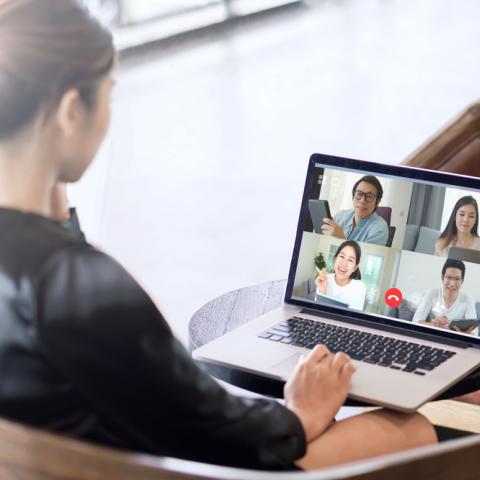In this new era of students and professionals working and learning from home, it may seem like things are at a standstill when thinking about how to further oneself in new positions, trying to secure an internship or seek out first-time jobs.
However, in this time of social distancing, more people in all sectors of business, education and government are welcoming the opportunity for professional face-to-face video chats. Therefore, it is important to be properly positioned for this type of engagement.
Consider some strategies to prepare you for video engagement before and during video conferences.
Pre-video conference: take steps to make you and your new at-home workspace ready. While many people recognize they won’t be seeing an office setting, your at-home environment is a reflection on your professionalism. Tips include:
- Evaluate the look and feel of the space itself. Be sure the room/area in which you will be seen in video conferences is clean. Remove any elements that would hinder a professional looking conversation.
- Prepare seamless audio. Test out your computer’s audio with friends or family members before a major call to be sure you’re coming in clear and at a good audio level.
- Determine your best angle. Think about how you are positioning your phone or laptop during a video call—try to position your device or computer at eye-level so you’re looking into the camera, which will feel like more direct eye contact versus looking down into the screen, which generally isn’t the most flattering or professional image.
- Ensure optimal device support. While video conferences can be conducted on any smart device or computer, larger group chats will only show one or just a few people on screen, so when possible, use a laptop or desktop computer for video sessions.
During the video conference: set the stage for meaningful discussions, without interruptions or technical difficulties. Once a video conference is scheduled, take these steps to position it for success:
- Look professional from top to bottom. Many of us know the game of wearing professional attire above our waist and wearing cozy pants below the waist. After all, who will see it, right? We recommend always wear appropriate clothing from head to toe. You never know if you’re going to have stand up to shut a door or grab something away from the computer.
- Confirm the video format. Be sure there is a mutual agreement that the session will be a video conference. If you initiated the session and see that some participants are audio-only, ask members if they would prefer audio only, or if instead they would rather turn the video feature on. ALWAYS give people notice if you’d like the session to be video-based; while everyone is working at home and has ready access to technology, many might not feel video-ready.
- Give members of your household a heads-up. Given that many of us are now working/learning from home, give your at-home house members a heads-up that you’ll be on a video call and put a sticky note on the door of your video conferencing room (assuming you’re in a separate room) as a reminder.
- Log in on time. If you are using the video platform for the first time, log in early. Sometimes being a first-time user can take a bit longer to load—or you may need to register. Being late to a virtual meeting means the host has to restate information that you missed.
- Be ready to share. In the event you are asked to share your screen, be sure your on-screen desktop is clear and all your personal browsers are closed. Do this in advance of the video conference.
- Stay engaged. In-person, it’s much easier to stay engaged and maintain eye contact. On a video conference, do your best to stay engaged—whether it’s on a group conference or a one-on-one session. It’s easy to identify when someone is checking their emails and phone or looking elsewhere.
- Avoid distracting ambient noise. If you’re not speaking and you are in a louder area, mute your microphone so the group doesn’t pick up background noise from your environment.
- Overcome large group imbalances. For larger groups, it’s challenging for all members to evenly talk or offer thoughts during a video conference. If you’re coordinating the call, emphasize to everyone that you’d like all participants to weigh in as they see fit when opportunities for input and discussion arise. If you (or other participants) feel like responding or sharing insights could be difficult, consider politely raising your hand when the camera is on; doing so will note that you have something you’d like to share.
- Be sure you’re logged off. Nothing is worse than saying something on camera that you wish you wouldn’t have said. Always double-check that your camera is off and the session has ended.
Contributed by:
Evren Gurkan-Cavusoglu, Ph.D.
Associate Professor, Electrical, Computer, and Systems Engineering
Faculty Director for CWRU WIT Initiative
Case Western Reserve University
Michelle Burgess
Content Manager, CWRU WIT Initiative


